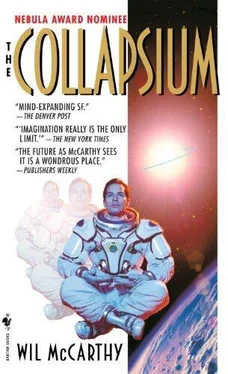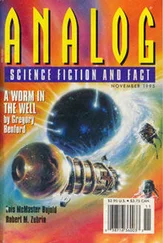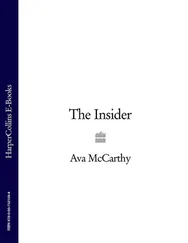Light-hour(n) The distance traveled by light through a standard vacuum in one hour. Equal to 3,600 light-seconds, or 1,079,252,848,8 kilometers.
Light-second(n) The distance traveled by light through a standard vacuum in one second: 299,792.46 kilometers.
Lithosphere(n) The rocky outer crust of a terrestrial planet, composed primarily of silicon dioxide.
Lorentz-invariant(adj) Exactly the same at all velocities. The zero-point field is thought to be Lorentz-invariant.
Afa/o e lelei Traditional Tongan greeting, widely used within the Queendom. Literally translated as, “Thank you, hello.”
Meson(n) member of the class of high-rest-mass, integer-spin particles that include the pion, kaon, rho, omega, eta, psi, B, and D. Mesons are composed of a quark-antiquark pair, and are subject to the hypothetical “strong nuclear force” of quantum-age physics.
Milligee(n) One one-thousandth of the acceleration experienced by a body at rest on either pole of Earth’s reference ellipsoid (i.e., ‘/iooo of one gee); 0.0098202 meters per second squared.
Monocrystalline(adj) Composed of a single crystal, without seams and, ideally, without flaws. Sometimes used colloquially as a term of admiration.
Morbidity filter(n) One of dozens of software filters applied to human patterns in the Iscog, intended to eliminate mortality by disease and age-related deterioration. Attributed to Ernst Krogh.
Muon(n) An unstable lepton possessing charge +1 and mass /9 that of a proton, with a half-life of 10“ 6seconds.
Nanoassembler(n) Any device capable of assembling objects at the atomic level. Most nanoassemblers (e.g., the standard fax machine) are of macroscopic size.
Nasen(n or adj) An acronym for “neutrino amplification through stimulated emission.” A coherent neutrino beam sometimes employed for interplanetary communication thanks to its extremely small divergence angle. However, the difficulty of generating such a beam, plus its ready interactions with matter, limit its usefulness.
Nescog(n) Successor to the Iscog; a high-bandwidth telecommunications network employing numerous supraluminal signal shunts.
Neuble(n) A di-clad neutronium sphere, explosively formed, usually incorporating one or more layers of wellstone for added strength and versatility. A standard industrial neuble masses one billion metric tons, with a radius of 2.67 centimeters.
Neutronium(n) Matter that has been supercondensed, crushing nuclear protons and orbital electron shells together into a mass of neutrons. Unstable except at very high pressures. Any quantity of neutronium may be considered a single atomic nucleus; however, under most conditions the substance will behave as a fluid.
Piezoelectric(adj) Describes a substance, often crystalline, that produces a voltage when pressure is applied to it, or which experiences mechanical deformation in response to a voltage.
Perihelion(n) The point of an orbit that lies closest to the sun.
Petajoule(n) 10 15joules or watt-seconds. A measure of energy equivalent to the vaporization of 2.985 million tons of liquid water at boiling point.
Philander(n) A title granted to formal consorts of the Queen of All Things. Only four Philanders were ever named.
Photopause(n) The irregular, granulated “surface” of a star.
Photosphere(n) The hot, opaque, convectively stable plasma layer of a star beginning at the photopause, responsible for most thermal and visible emissions. Usually less than 1000 kilometers deep, with temperatures of several thousand kelvins and the approximate pressure of Earth’s stratosphere. The photosphere floats atop the deep hydrogen convection zones of the stellar interior.
Picosecond(n) 10 12seconds; a measure of time roughly equivalent to the vacuum travel of light across a gap of 0.3 millimeters.
Pion(n) An unstable, spin-zero meson possessing ‘/§ the mass and +1, 0, or –1 times the charge of a proton, and a half-life of 2.6·10 –8seconds.
Plibble(n) Fruit of the plibble tree. Origin unknown.
Pseudoatom(n) The organization of electrons into Schrodinger orbitals and pseudo-orbitals, made possible with great precision in a designer quantum dot. The properties of pseudoatoms do not necessarily mimic those of natural atoms.
Pseudochemistry(n) Electron shell interactions taking place among pseudoatoms, or between pseudoatoms and natural atomic matter.
Quantum well(n) A semiconductor designed to trap electrons in a two-dimensional layer thin enough for wave behavior to overwhelm particle behavior. The equivalent one-dimensional structure is a quantum wire. The nanoscopic, zero-dimensional equivalent is a quantum dot, capable of trapping electrons in pseudoatomic orbitals.
Quod eraf demonstrandum Latin: “which was to be proved.”
Random(adj) Aperiodic and nondeterministic; a condition in which any point, state, or member of a system, group, or set has an equal probability of being sampled. Colloquially, any system, group, or set whose forward characteristics are difficult to compute. Randomness is a hypothetical construct that does not occur in nature.
Reportant(n) A person or mechanism gathering information for public distribution.
Restoration, the(n) Interglobal election that established the Queendom of Sol under Tamra I. The term derives from the presumption that monarchy is the “natural” state of human beings, owing to a genetic predisposition.
Revpic(n) An acronym for “relativistically vibrating, para-infinite, Charged.” The word “plate” is generally presumed, and indicates a thin, rigid sheet of wellstone that serves as the primary component of a gravity projector.
Ring Collapsiter(prop, n) The first supraluminal signal shunt, intended to be part of the Iscog. Attributed to Marlon Sykes.
Sol(prop, n) Formal name for the Earth’s sun, derived from the Latin. The Greek Helios was considered archaic for most Queendom uses.
Superabsorber(n) Any material capable of absorbing 100% of incident light in a given wavelength band. The only known universal superabsorber (i.e., functioning at all wavelengths) is the event horizon of a hypermass. (Approximations of 100% absorption are generally referred to as “black.”)
Supercondensed(adj) Condensed to the point of proton-electron recombination, i.e., until neutronium is formed. Colloquially, condensed to any point the speaker finds impressive.
Superconductor(n) Any material capable of passing electron pairs with zero resistance. (Approximations of zero resistance are generally referred to as “conductors.”)
Supercooled(n) Cooled below the point of an expected phase transition, typically the freezing point of a liquid. Colloquially, cooled to any point the speaker finds impressive.
Superreflector(n) Any material capable of reflecting 100% of incident light in a given wavelength band. No universal superreflectors are known. (Approximations of 100% reflectance are generally referred to as “mirrors.”)
Supervacuum(n) A state of vacuum in which some wavelengths of the zero-point field have been suppressed or excluded. Since the speed of light is a function of vacuum energy, supervacuum is useful for the transmission of matter and information at supraluminal velocities.
Читать дальше












